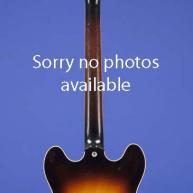A Very Early Epiphone De Luxe
This 16 3/8-inch-wide acoustic archtop guitar weighs just 4.80 lbs. and has a nut with of 1 3/4 inches and a scale length of 25 1/2 inches. Two-piece carved spruce top with three-segment f-holes, curly maple back and sides, three-piece maple neck with two mahogany center strips, and single-bound rosewood fretboard with 20 frets and inlaid pearl notched-diamond and triangle position markers. Asymmetrical headstock with inlaid pearl "Epiphone" logo and "Masterbilt" banner. Open-back Grover tuners with oval metal buttons. The pickguard has been removed. Rosewood bridge with pearwood base and trapeze tailpiece. The trapeze tailpiece has been expertly repaired. The back of the guitar is slightly flamed and, apart from some very insignificant cracking on the binding, the guitar is in remarkable condition. Expertly refinished on the body and neck. Housed in a later black hardshell case with black plush lining (9.50).
"In June 1931 the Epiphone Banjo Company unveiled 12 new f-hole archtop guitars, a move designed to wrest the title of the world's leading archtop guitar maker away from Gibson. Epi even tried to usurp the name of Gibson' best models -- the Master Model (Style 5) line of mandolins and guitars and the Mastertone banjos. Epi's models were called Masterbilt, and they said so right on the peghead. All had f-holes like Gibson's L-5, although Epi's f-holes were cut out in three segments rather than one continuous hole. The top Epi model, the De Luxe, was fancier and bigger (3/8" wider) than the Gibson. Where the L-5 had rectangular mother-of-pearl blocks on the fingerboard, the De Luxe had a more delicate, elegant pattern of hearts and diamonds. Where the L-5 had a small flowerpot as a peghead ornament, the De Luxe had two pearl banners engraved with 'Epiphone' and 'Masterbilt.' Between the banners the model name was engraved. The peghead was topped off with a Gibson-type dip, but it was offset from the center, like a hat worn at a rakish angle...The introduction of the Masterbilts was intended to be a killing blow to a company that was already reeling from the depression...But Gibson soon recovered enough to mount its own counterattack, and through the 1930s, these two heavyweights landed blow after blow on each other. But unlike boxers, they -- and the guitar world along with them -- rose to greater and greater heights as a result of the competition" (Walter Carter, Epiphone: The Complete History, p. 20).
"The De luxe was the original top-of-the-line Epiphone Recording Banjo, and it topped the Masterbilt guitar line, too. It was essentially a Gibson L-5 -- with a little bit extra. It measured 16 3/8" across the lower bout, which was just enough bigger than the Gibson to be noticeable. The back and sides were of maple and the top of spruce. The f-hole shape was different -- not continuous like the f-hole on a violin or Gibson's L-5, but with scroll ends separated from the middle, dividing each f into three segments or three actual holes. Rope-pattern purfling ran around the inner border of the top. Small heart and diamond shapes decorated the fingerboard, an elegant contrast to the huge rectangular pearl blocks on the L-5. The peghead was where the De Luxe strutted its best look. The front was overlaid with black plastic, with three inlaid mother-of-pearl banners, engraved (reading top to bottom) 'Epiphone,' 'Deluxe,' and 'Masterbilt.' Floral figures were inlaid between the banners. The appearance of binding was created by adding an underlayer of white plastic and then beveling the edges of the peghead so that the white layer was visible from the front of the guitar. The back of the neck had a shapely 'volute,' a violinlike feature, accentuated by binding. The top of the peghead had a most unusual dip, or notch, well to the right of center, that made the new Epiphone models instantly identifible from a distance" (Walter Carter, Epiphone: The Complete History, p. 23).
Translate:

